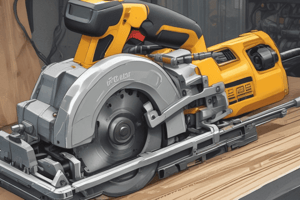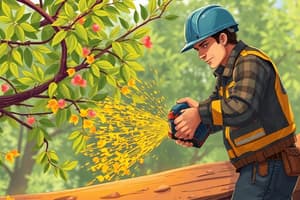Podcast
Questions and Answers
What should be done immediately if a power tool malfunctions?
What should be done immediately if a power tool malfunctions?
- Check the manual for troubleshooting steps.
- Put it aside and use a different tool.
- Unplug it and stop using it immediately. (correct)
- Continue using the tool as it is still somewhat functional.
Which of the following best describes the benefit of regular maintenance on power tools?
Which of the following best describes the benefit of regular maintenance on power tools?
- It completely eliminates the need for cleaning.
- It minimizes energy consumption when using the tool.
- It prolongs the lifespan and optimizes performance. (correct)
- It prevents environmental pollution during use.
How do power tools contribute to environmental pollution?
How do power tools contribute to environmental pollution?
- They have no impact on the environment.
- Their manufacturing process and use impact the environment. (correct)
- They are made from 100% recyclable materials.
- They consume less energy than manual tools.
Which practice is essential for safe operation of a power tool?
Which practice is essential for safe operation of a power tool?
What is a recommended practice after using a power tool?
What is a recommended practice after using a power tool?
What is one characteristic measured in watts or horsepower that indicates a power tool's capacity to perform work?
What is one characteristic measured in watts or horsepower that indicates a power tool's capacity to perform work?
Which type of power tool uses compressed air for operation?
Which type of power tool uses compressed air for operation?
What safety feature is essential for minimizing risks when using power tools?
What safety feature is essential for minimizing risks when using power tools?
When selecting a power tool, which factor is NOT a consideration?
When selecting a power tool, which factor is NOT a consideration?
Which power tool is primarily used for making holes and driving screws?
Which power tool is primarily used for making holes and driving screws?
What is a common use for a circular saw?
What is a common use for a circular saw?
What aspect of power tools is indicated by revolutions per minute (RPM)?
What aspect of power tools is indicated by revolutions per minute (RPM)?
Which of the following best describes pneumatic power tools?
Which of the following best describes pneumatic power tools?
Flashcards
Power Tool Cleaning
Power Tool Cleaning
Keeping the tool clean after use, removing dust, debris, and sawdust.
Right Tool for the Job
Right Tool for the Job
Using the right tool for the job ensures safety and efficiency.
Avoiding Fatigue and Substance Use
Avoiding Fatigue and Substance Use
Always operate tools with fresh energy and a clear mind.
Power Tool Maintenance
Power Tool Maintenance
Signup and view all the flashcards
Power Tool Disposal
Power Tool Disposal
Signup and view all the flashcards
What are power tools?
What are power tools?
Signup and view all the flashcards
What's the difference between cordless and corded power tools?
What's the difference between cordless and corded power tools?
Signup and view all the flashcards
What is 'power' in a power tool?
What is 'power' in a power tool?
Signup and view all the flashcards
What is 'speed' in a power tool?
What is 'speed' in a power tool?
Signup and view all the flashcards
What is 'torque' in a power tool?
What is 'torque' in a power tool?
Signup and view all the flashcards
What are safety features in power tools?
What are safety features in power tools?
Signup and view all the flashcards
What are the key considerations for choosing a power tool?
What are the key considerations for choosing a power tool?
Signup and view all the flashcards
What are the safety procedures for operating power tools?
What are the safety procedures for operating power tools?
Signup and view all the flashcards
Study Notes
Power Tool Categories
- Power tools use mechanical power for tasks, more efficient than hand tools.
- Categories include:
- Cordless: Run on batteries, portable.
- Corded: Run on electricity, need a power outlet.
- Pneumatic: Use compressed air, often industrial.
- Specific types exist for various tasks (woodworking, metalworking, construction).
Power Tool Characteristics
- Power: Measured in watts or horsepower, indicating work capacity.
- Speed: Measured in RPM, affecting cutting/grinding efficiency.
- Torque: Rotational force, crucial for high-pressure tasks or tightening.
- Safety features: Overload protection, automatic shutoffs, trigger locks reduce risks.
- Durability: Robust materials, longer tool life, stable performance.
Power Tool Selection Considerations
- Task: Different tasks require different tools.
- Material: Wood, metal, plastic need tools with specific properties.
- User experience: Comfort, ergonomics, weight affect usability, safety.
- Budget: Cost varies with features and brand.
- Brand reputation: Established brands often have higher quality and support.
- Safety: Tools must meet safety standards.
Main Types of Power Tools
- Drill/Driver: For making holes and driving screws.
- Saw: For cutting materials (circular, miter, reciprocating).
- Sander: For smoothing surfaces.
- Grinder: For grinding and sharpening.
- Router: For shaping and contouring.
- Impact driver: For driving screws in hard-to-reach areas.
- Circular saw: For cutting wood, metal, etc.
- Reciprocating saw: For cutting various materials with a back and forth motion.
- Planer: For smoothing or shaping wood surfaces.
Power Tool Operation Safety Procedures
- Follow manufacturer instructions.
- Wear appropriate safety equipment (gloves, eye protection).
- Check tool for damage before use.
- Keep work area clear of obstructions.
- Avoid operation when fatigued or impaired.
- Use the correct tool for the task.
- Keep hands and fingers away from cutting edges.
- Immediately stop use and unplug if malfunctions occur.
Power Tool Maintenance
- Regular maintenance extends tool lifespan and performance.
- Cleaning: Remove dust, debris, and sawdust after use.
Environmental Impact of Power Tools
- Manufacturing and potential use contribute to pollution.
- Energy usage and material sourcing affect environmental footprint.
- Disposal of old tools requires recycling.
- Manufacturers explore alternatives to reduce environmental impact.
Studying That Suits You
Use AI to generate personalized quizzes and flashcards to suit your learning preferences.




